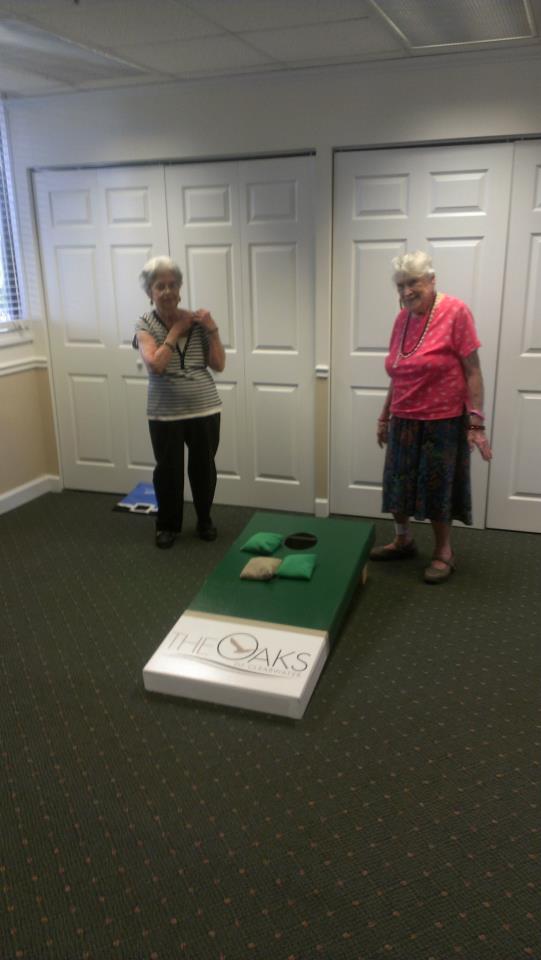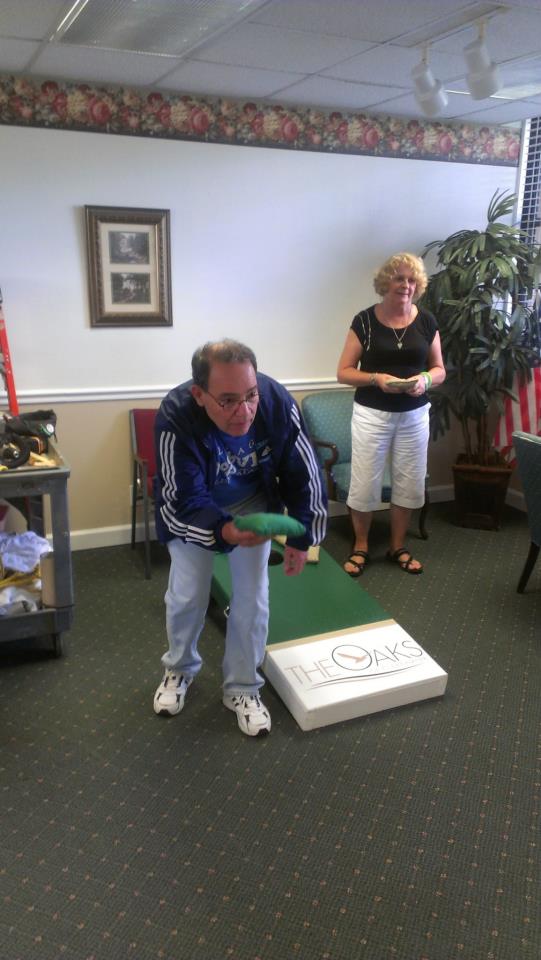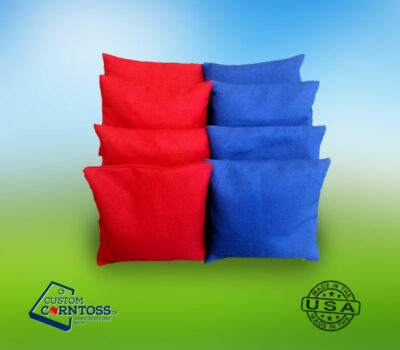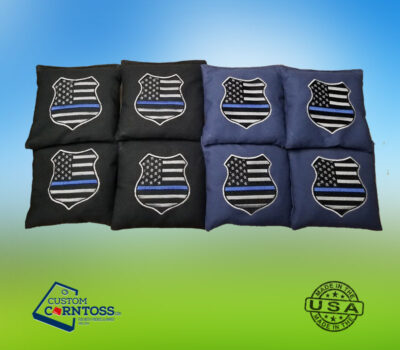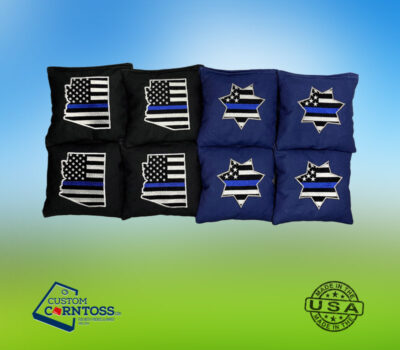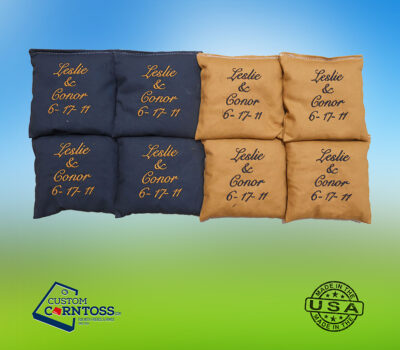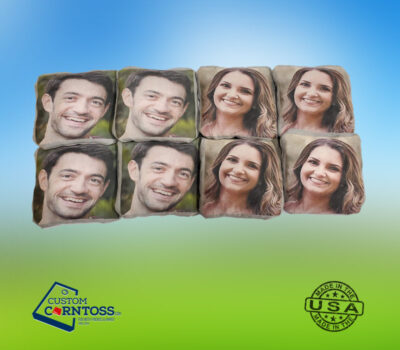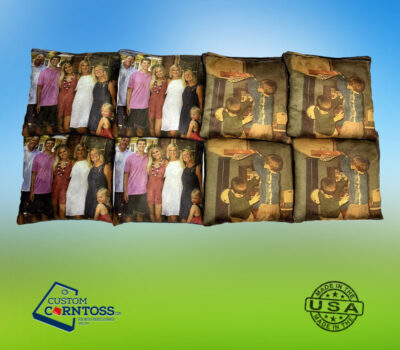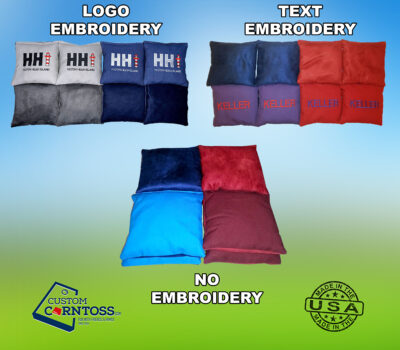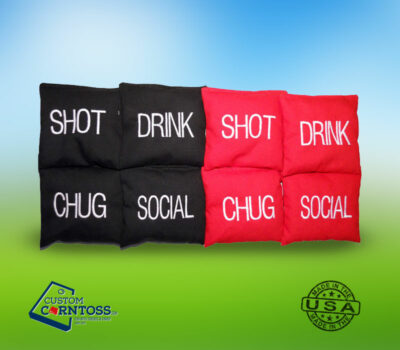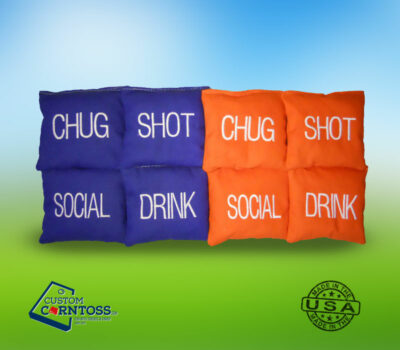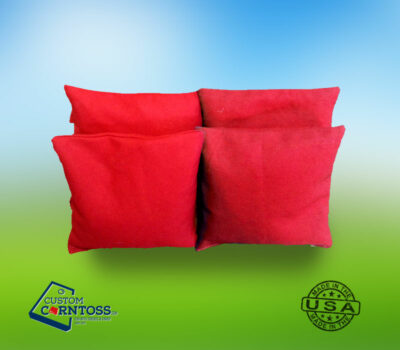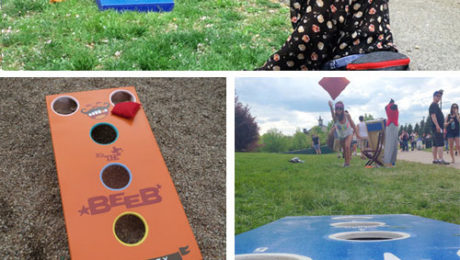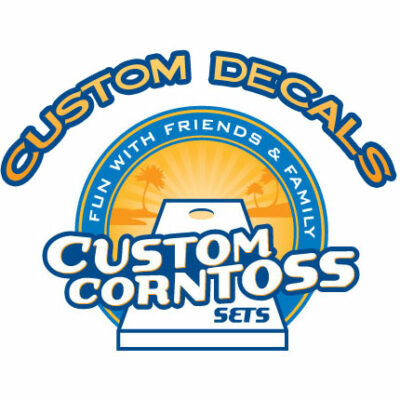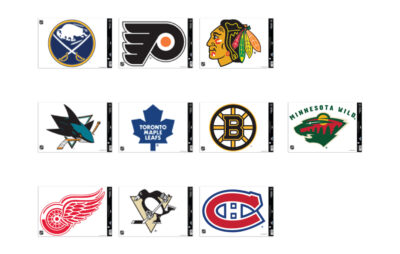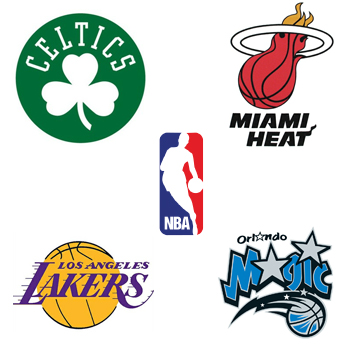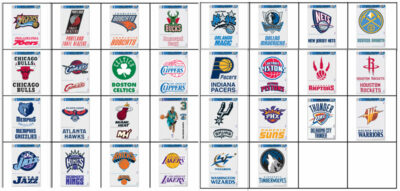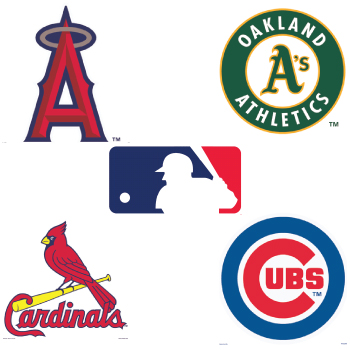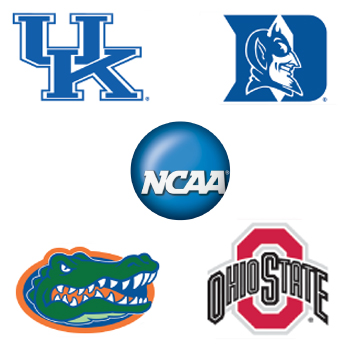Cornhole Information
Benefits Of Playing Cornhole For Senior Citizens
As we age, vision, depth perception, balance, and coordination can decline. We have clients that work at retirement communities that rave about how much senior citizens enjoy their cornhole set. It gets them active and aids critical hand-eye coordination and balance.
Folks from the Oaks Playing Indoor Cornhole
Mobility and Leg Strength
The very machinations of how a cornhole bag is thrown are beneficial to seniors. It’s recommended that seniors walk heel-toe to improve mobility and leg strength and that’s what one has to do to when throwing a cornhole bag.
Balance and Hip Mobility
It’s also recommended that seniors balance on or shift their weight from one leg to another. When tossing a cornhole bag one generally takes a large stride from one leg to another. This motion is good not only for balance but also for hip mobility.
Depth Perception and Vision
In advanced years, depth perception often declines. This can be simply due to age, eye trauma, or overuse of one eye. There’s a common technique to aid depth perception if one eye is stronger than the other and its called “patching”. This is where the wearer places a patch over the stronger eye to exercise the weaker one. This treatment in combination with a game like cornhole where one must aim for the board or the hole can be a fun and effective therapy.
In general, vision declines with age and it can be beneficial for any senior citizen to play cornhole as it connects eyes, brain, and body in a stress-free and fun way.
Design Your Own Custom Cornhole Boards
Purchase a cornhole board today for the senior citizens in your life. It’s a fun, easy game to keep them spritely. Order online today to get customizable cornhole boards for your elderly family members or retirement community.
- Published in Information
Custom Bag Embroidery Tips
Tips when ordering embroidered bags.
You can embroider logos, simple text or names, or any design you’d like onto the bags. Just remember the following tips when designing your bags.
Simple Text Embroidery
The color of your cornhole bags should be a color the embroidery will show up on. So if you have a navy blue bag you should go for a white, yellow, or another bright color embroidery so it pops.
Bag Color List:
Black, Brown, Camo, Crimson, Fuschia, Gray, Hunter, Kelly, Khaki, Navy, Nutmeg, Olive, Orange, Purple, Red, Royal, Sky, Turquoise, White, Yellow
Embroidery Color List:
Black, Brown, Burgundy, Burnt Orange, Camo, Coral, Crimson, Gray-Dark (Pewter), Gray-Light, Gray-Medium, Hunter, Kelly, Khaki, Lime, Navy, Nutmeg/Dark Gold, Olive, Orange, Pink Dark (Fuchsia), Pink Light, Purple, Red, Reversed, Royal, Sky Blue, Teal, Turquoise, White, Yellow
Logo Embroidery
Logos can be embroidered on your bags. It’s important again to consider your logo colors and the color of your bags to make sure the logo isn’t drowned out by the bag color.
Changing Your Logo Colors
If you want to change the color of your logo to fit the bag color simply make that distinction in the comment box.
There are various options for logos. For example if your logo is blue and red, but you want blue bags we can change the logo to red and white and embroider it on a blue bag.
Negative Space
Negative spaces in logos can be a fun aspect of your bags since the negative spaces will be filled by the bag color.
Common Problem
If the logo you are uploading has a white background please put in the message box if the white is transparent or needs to be embroidered in the logo. We do not embroider boxes around the logo unless it is designed to be in the logo.
Color of the Bags
While no one can tell you what looks good there are general rules for what colors match best. Here’s a color guide for reference:
Color Combos Cheat Sheet
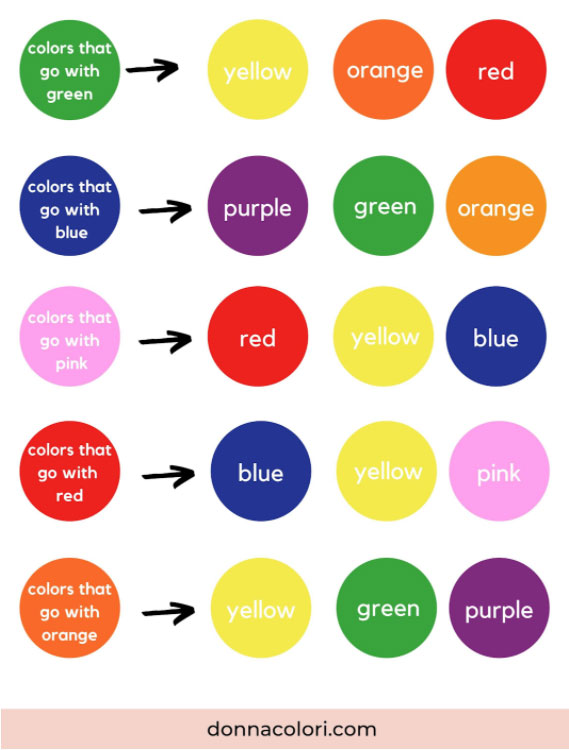
Still Unsure of Your Design?
Contact our sewing department with any questions. They will be happy to give you advice on colors and design.
Shop Cornhole Bags
- Published in Information
Custom Cornhole Boards
Make a statement with your cornhole boards. Did you know you can customize your cornhole bags and boards? Custom Corntoss will add any design or logo to your boards. In this blog, we will discuss how to add your logo/design to a board, customizations, add ons, and types of materials your board can be made from.
Types Of Boards
Traditional Cornhole Boards and 5-Hole Boards are the two types of boards we carry. Traditional wood boards are the classic single hole cornhole boards that you have come to know and love, while the 5-Hole boards are a fun twist to the traditional board and have 5 holes with which to score that have varying levels of point values.
Graphics And Branding Your Boards
Add your logo or image to the cornhole or 5-Hole boards for your home or business. Take your branded boards to events for a unique way to spread your brand awareness, or dress up the plain wood boards for the backyard with your own pictures, color scheme and design. There are various customizations to create your own unique branded boards.
How To Add Your Logo To A 5-Hole Board
- Go to the custom 5-Hole boards product page
- Scroll down to the section that says ‘Print-Size Board Logo Upload’
- Upload your logo files (Vector File)
- You can select up to two logos. If only one is chosen that logo will be printed on both boards
How To Add Your Logo To A Cornhole Board
- Go to the custom cornhole boards product page
- Scroll down to the ‘File Upload’ section
- Upload your logo (Vector File)
- You can select up to two logos. If only one is chosen that logo will be printed on both boards
How To Wrap Your Boards
- Go to the custom wrap cornhole boards page
- Scroll down to the section that says ‘Graphic’
- Upload your graphic(s) (Flattened PDF)
There’s a template available for you to create your graphic on under the upload boxes.
Board Designer
In addition to the board options mentioned above, we have a board designer where you can browse all possible designs and customize them the way you want. Change the colors of the board, change the accent color, change the bag color, etc. Truly make your own unique design.
Available Bag Customizations
- Custom bag colors
- Each set of four bags can be a different color
- Custom board colors
- 23 colors to choose from
- Bag embroidery/print logo
Add-Ons
Make your Cornhole experience even better with add-ons like score strips, score towers, LED lights, koozies, and more.
Score strips
Keep score easily with these strips that adhere to the back of your cornhole board for easy, accurate score management.
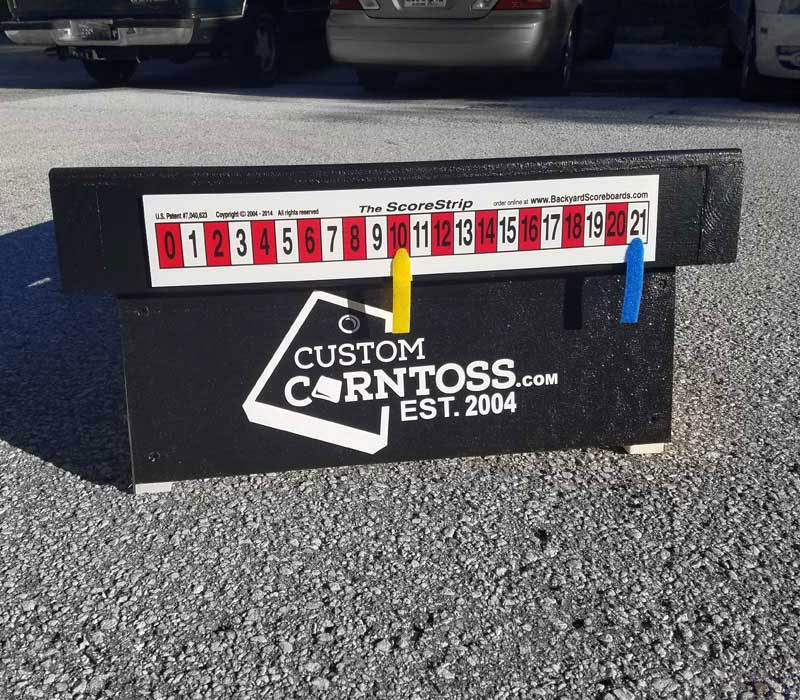
Score towers
Score towers are another easy way to keep score. The freestanding towers make it so you don’t even have to bend over to change scores. Purchase the drink holder for extra convenience!
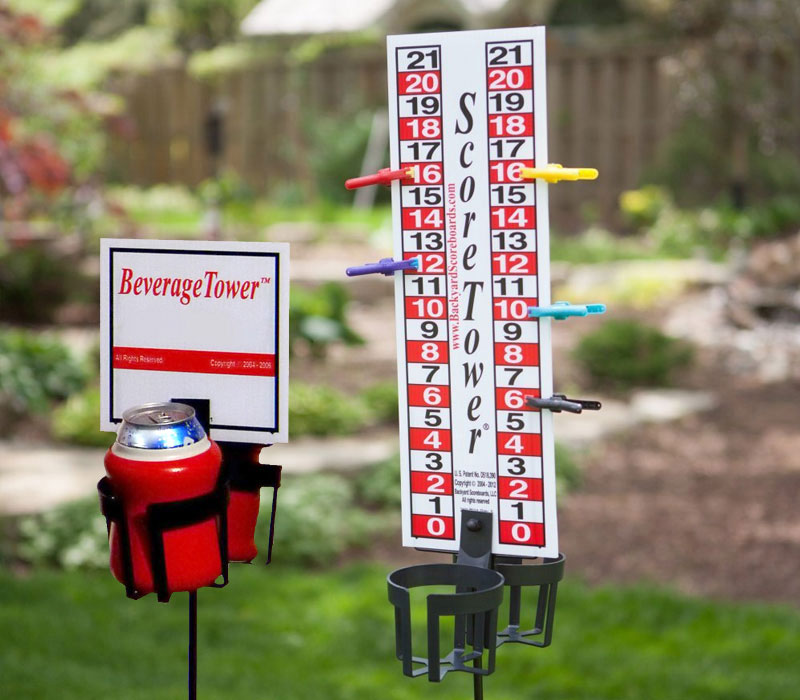
Tote bag
Use this tote bag to carry around and store your bags. Never lose or ruin another cornhole bag again.
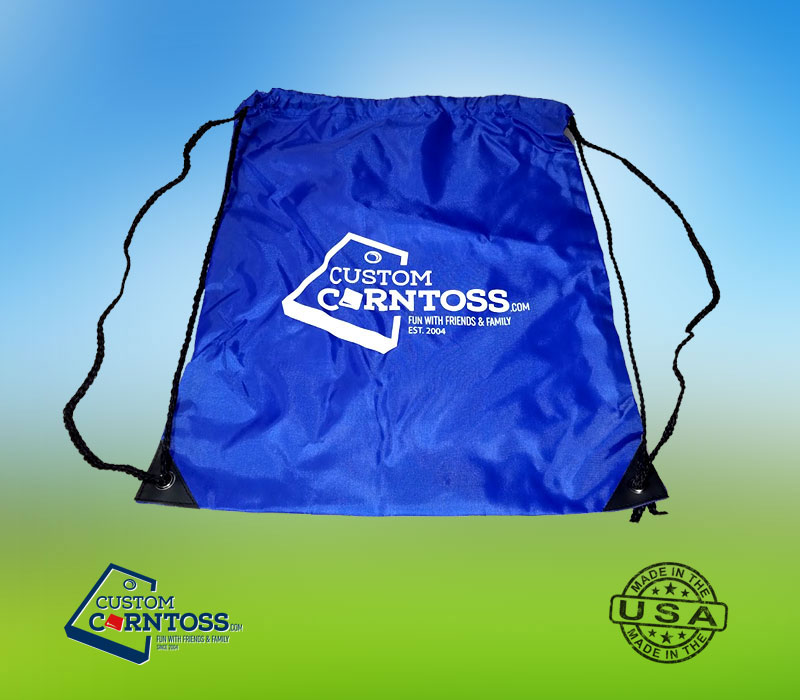
Scorekeeping beer koozie
Have your drink and score it too. These koozies are designed with scoring rings on the koozie so you can keep an accurate score without the drink ever leaving your hand.
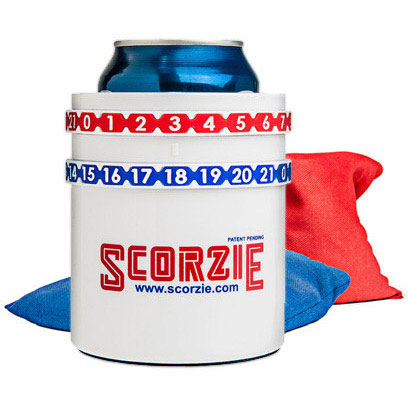
Place a company logo, team logo, or even your name on your boards for a customized playing experience. Your boards are that much more special when they’re customized. Place an order for your new unique boards in just a few minutes for fun for years to come.
- Published in Information
What Is 5-Hole? The New Cornhole Game
It’s summer which means company barbecues and mingling. What’s the best addition to any event? Some friendly competition over a game of cornhole. But you don’t want just a regular cornhole board that your people have been playing with their whole life. No, you want that extra challenge. This is where 5-Hole cornhole boards come in. This game not only increases the difficulty but the precision at which you aim. In this blog, we will discuss who invented the boards, how to play, and where to buy these unique boards.
Background On The 5-Hole Game
This unique twist on cornhole was invented by a man named Eric Pavony. He’s the owner of a Skee-Ball® bar called Full Circle Bar in Brooklyn, New York and Austin, Texas. He had the idea to combine cornhole with aspects of competitive Skee-Ball® and thus the 5-Hole board was born
5-Hole boards are patented. This means any board you find anywhere else that has five holes is a patent violation. You can only find the genuine 5-Hole boards here.
The name Five Hole Cornhole is a registered trademark and may be used only with permission.
The Similarities And Differences Between Cornhole And 5-Hole
Similarities
- Aiming to get the bag in a hole
- Get one point just for landing on the board
- The same foul line applies
- Same tossing style
- Same board dimensions
Differences
- The 5-Hole holes have different point amounts associated with them
- Play 10 frames in 5-Hole where you throw all four bags instead of alternating tosses after each throw
- The goal of 5-Hole is to have the most points at the end of 10 frames as opposed to playing to 21 points
What The Boards Look Like
The boards are the same 24×48 inch cornhole boards you are familiar with and they come with…you guessed it, five holes. These five holes have point totals assigned to each. There are three holes vertically in the center of the board with the lowest hole being two points, the middle hole being 3, and the highest hole being 4 points. Then there are two more difficult holes to aim for on the top left and right corners of the board and those are worth five points.
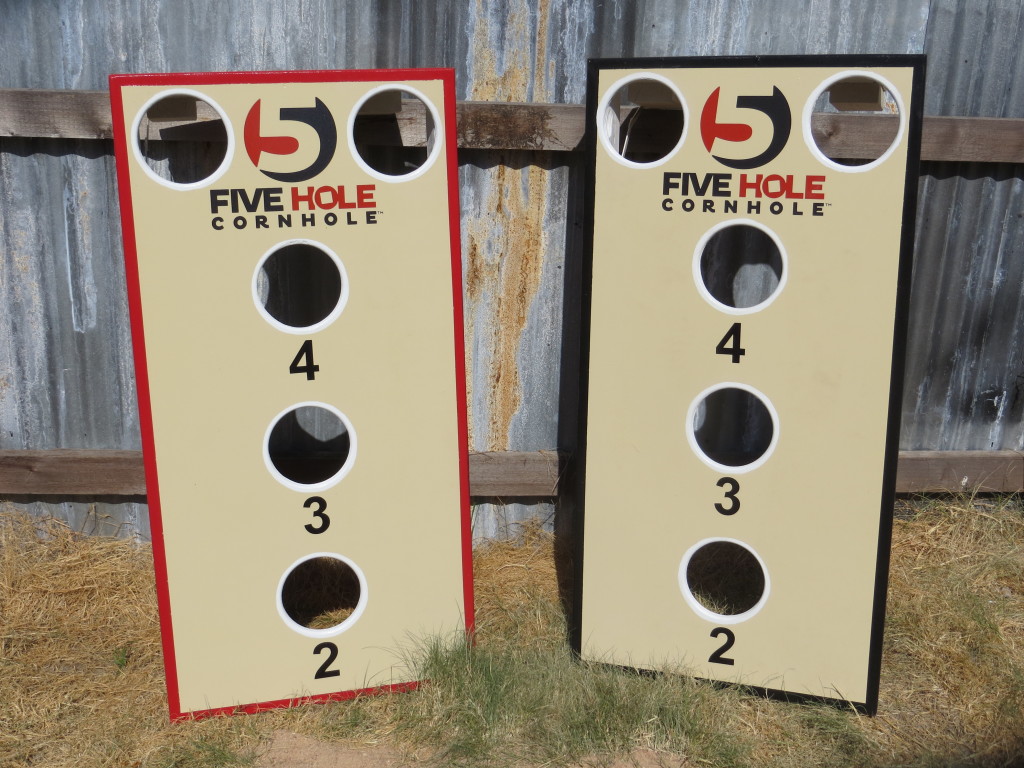
How To Play
- If you’re playing doubles you will stand with your opposing teammate next to one board and your teammate will stand with their opposing teammate at the other board
- Decide which team throws first
- One team will throw their four bags then the other team will throw their four bags
Remember not to cross the front of the board, that’s the foul line
- You will alternate like this until each of you throw your four bags- this is considered one frame
- Tally points at the end of each frame for 10 frames
- Tally the points at the end of the game the team with the highest score is the winner
There is another version of 5-Hole where the first team to 50 points is the winner.
Here’s a link to an in-depth look at the rules.
Purchase Your 5-Hole Boards
Add 5-Hole to your collection of games for a new twist on a fun classic. Purchase these durable boards from us for years of play. You can even customize your 5-hole board your boards with any logo or color you want.
- Published in Information
Learn About Cornhole Tournaments
Cornhole has evolved from just a backyard barbecue game to well organized leagues and divisions across the country. What was once a simple game among friends has now become a nationally televised sport! In this article, we outline the basics of how to play Cornhole, how to find and join a cornhole league in your area, and how you could even find yourself on national TV playing cornhole for awards and prizes.
As with any professionally organized activity, there are some rules and regulations to follow. Below you will find some of the basic rules of the game.
Cornhole Tournament Equipment Rules:
- The board must be two feet by four feet
- The board must be angled 12 inches from the ground at its highest point
- The board must be three to four inches from the ground on the low end
- The six inch hole must be directly in the center of the board and nine inches from the top
- Bags must measure six by six inches and weigh 15.5-16.5 ounces
Cornhole Board Placement During a Tournament:
- Measured from the front, or low end, the boards should be placed 27 feet apart
- Cornhole (also referred to as corntoss) boards should be lined up evenly with each other.
Here is a video explaining how to set up your cornhole game and how the score is kept.
How To Play
- If you’re playing doubles you will stand with your opposing teammate next to one board and your teammate will stand with their opposing teammate at the other board.
- You will decide which person from each team throws first, if you’re playing one on one this step is not necessary
- One team will throw the first bag then the other team will throw their first bag
- Remember not to cross the front of the board, that’s the foul line
- You will alternate like this until each of your four bags is thrown
- Getting your bag in the hole is worth the most points so that’s what you should aim for
- You play until one team or player reaches 21 points and that team is the winner.
This video teaches you the basics of how to throw a bag and even how to play with a defensive edge.
Tips From Pro Cornhole Players
Did you know there are multiple different ways to hold a bag? They all affect how the bag moves in the air and slides along the board. Perfect your “pitching style” and become a pro.
How To Join A Local League
There are various leagues set up across the country that you can join. Most of these are just for fun…but you can win some moo-lah. 32 states have local cornhole leagues you can join.
Once you find a league you’d like to join. They will typically have a registration section on their website. This is where you will pay for yourself or your team to participate in a scheduled tournament.
Here is an example of what a registration and information page will look like:
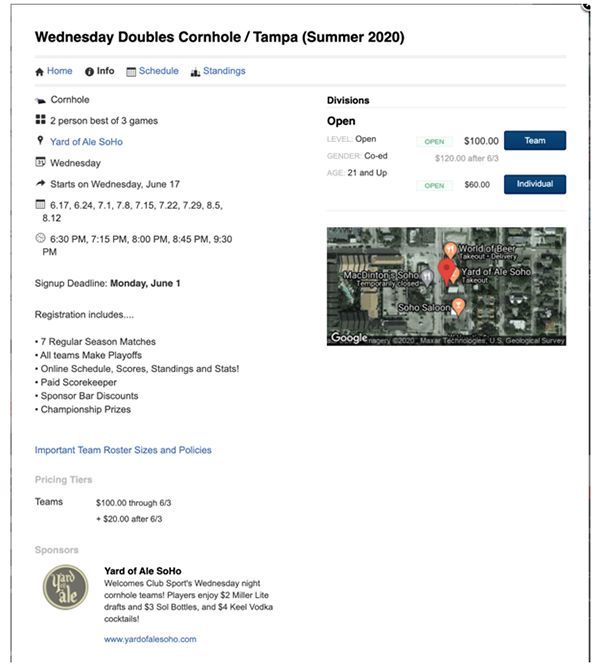
Professional Cornhole Organizations
There are two professional cornhole organizations that allow players to play both socially and professionally. They are the American Cornhole Organization and the American Cornhole League.
The ACO is the older of the two organizations. It was founded in 2004 and its contribution to the game is the two sided bags.
The ACL is the newer of the two organizations, but it’s more famous due to its presence on ESPN.
How To Qualify To Be A Professional Cornhole Player
There are currently 80 people with the pro title in the ACO and 97 registered pro teams in the ACL.
To become a pro in the ACL follow the following steps:
- Purchase an ACL membership, this costs $25. This membership allows you to compete against others at your skill level. You can play out of your skill level…if you can handle the competition.
- Becoming a registered ACL member allows you to be seen on the national standings, access statistics, and receive discounts when applying for ACL regional, conference, and national events in the future.
- Once you’re a member you will have a player profile assigned to you. This shows your age group and skill level
- Junior, College, Adult, Senior
- 1 Bagger, 2 Bagger, 3 Bagger, 4 Bagger, Premier, Elite
- ACL directors will place you in divisions that match your skill level
- Backyard, Social, Competitive, Advanced
- Once you’re an established player you play in local, regional, conference, and national tournaments. The creme de la creme gets to compete at the Championship of Bags for a chance to win $50,000. This is a nationally televised event that’s hosted by ESPN.
To become a pro in the ACO follow the following steps:
- Purchase an ACO membership, the cost is $35.
- You will be added to the ACO ranking list
- You will have access to a player profile with all of your info and statistics
- You’re eligible to earn ACO World Ranking points at ACO Regionals and ACO Majors
- You would be eligible to compete at the ACO World Championships of Cornhole
Regulations By ACL
The ACL used to have regulations in place for what bags were approved, they have since lifted this rule. For the 2019-2020 season players can bring their own bags to tournaments. They must within the regulations of 15.5-16.25 ounces and 5.75 and 6.25 inches when laid flat. The material cannot leave residue on the board, but it can be made out of any material whether it’s woven, non-woven, or knitted. Here is an in depth list of bag requirements. Popular bags brands are listed on the ACL website along with the types of bags that are permitted by the ACL, the list even includes grandfathered bag types.
Professional Cornhole Divisions
The United States is broken down into 14 professional divisions.
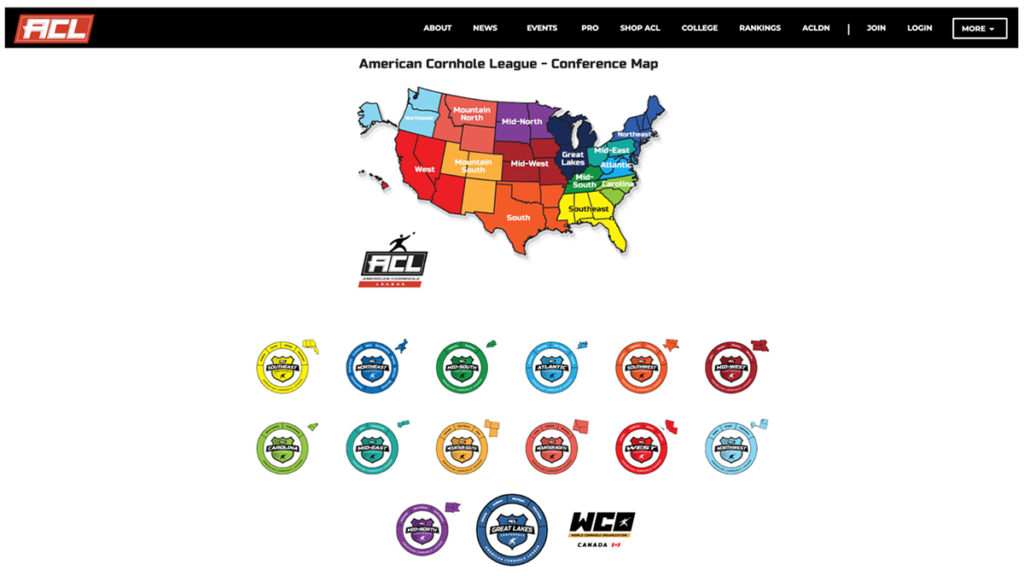
How To Find Regional Tournaments
Here is a photo taken on the ACL website. To find events check out the events page on their website.
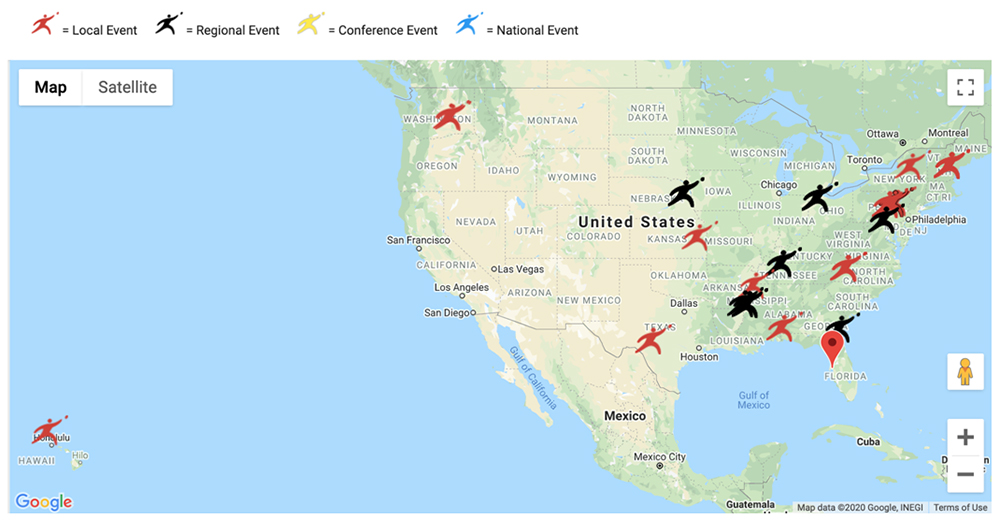
Stay Up To Date With ACL Statistics
The ACL has rankings for pro singles, pro doubles, singles, overall, conference, state, and virtual on their website. Keep up with your favorite participants. The ACO has their rankings listed on their website as well for pro players, world players, and virtual players.
Different Types Of Tournaments Hosted By ACL
- ACL Juniors – Tournament dedicated to children. They compete for prize money intended for their college tuition
- ACL College – Tournament designed ideally for college intramural cornhole teams, but any college age student team or college alumni team can participate. This provides scholarship money and money to be donated to booster clubs.
- ACL Championship – A tournament that spans a year that is determined by a points system. This tournament is designed for any age group and skill level. The competitions occur locally and regionally then progress to conference and national events.
- ACL Pro – Series of national events that is televised by ESPN
Televised Tournaments
Cornhole is a growing activity and ESPN recognizes the popularity of it. Cornhole tournaments are televised on ESPN 3. If you would like to view upcoming cornhole tournaments you can find them on ESPN.
Where To Follow ACL And ACO
ACL
- Twitter – @iplaycornhole
- Facebook – American Cornhole League
ACO
- Instagram – @americancornhole
- Twitter – @ACO
- Facebook – American Cornhole Organization
- YouTube – American Cornhole
- Published in Information
DIY or Buy: Custom Cornhole Wrap Boards
Cornhole is a great game because it can be as utilitarian or customized as you choose to make it. While hand-painting your boards is one way to customize your game set, a much faster, easier, and cheaper option is to get custom cornhole wrap boards.
What are Wrap Boards?
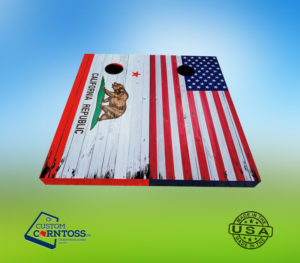 As the name implies, custom cornhole wrap boards are cornhole boards with a wrap on them! A wrap is like a giant decal sticker that covers the entire surface of the board.
As the name implies, custom cornhole wrap boards are cornhole boards with a wrap on them! A wrap is like a giant decal sticker that covers the entire surface of the board.
It is possible to order wraps and apply them yourself, or you can opt to buy boards with your customized wrap already applied. Not sure which option to choose? Consider the following pros and cons.
Pros of DIY
Perhaps the biggest advantage of buying cornhole decals and applying them yourself is the cost. Full-size, customized cornhole decals are not necessarily cheap. However, if you already have cornhole boards, you can save yourself some money by just ordering the wrap and not another set.
DIY is a good option if you are confident in your ability to apply what is essentially a single sticker over a large surface area.
Cons of DIY
While the DIY method is cheaper than buying fully wrapped boards, remember that this is only true if you already have boards on hand that are primed and ready for a wrap. A few other drawbacks to applying the wrap yourself include:
- There is no forgiveness when applying a decal. You have one chance to get it right. If you mess up and misplace the sticker, then try to peel it off, it will no longer adhere properly. If you decide to scrap the decal entirely, it is difficult to paint over the decal residue.
- It takes practice to apply cornhole decals without having too many air bubbles. The surface area of the boards is pretty significant, so you will surely want to enlist an extra pair of hands just to keep the air bubbles to a minimum.
- If you order your wrap online, it is possible that your measurements will be off so that the wrap does not fit your boards perfectly. It is a bummer when you start to apply the wrap then realize too late that the hole in the wrap and the hole in your board do not line up. Prevent this problem by laying the wrap over the board and inspecting it fully before starting to apply it.
- Most decals are not laminated, so you must also purchase and apply a water-based poly coating to protect the wrap from being damaged by water.
Pros of Buying Wrapped Board
To save yourself time and headache, it is a good idea to buy custom cornhole wrap boards with the wrap already applied. The pros include:
- If you don’t already have boards laying around, buying a wrapped cornhole set is not much more expensive than buying a regular cornhole set. Even better is that if you order wrapped boards, oftentimes the bags are included as well so you can start playing as soon as it arrives. You may also consider customizing your bags to match your wraps.
- Professionally wrapped boards will look better than DIY wraps. This is important to consider if the boards are a gift or if you are a business owner purchasing boards as an advertisement for your business.
- Buying customized boards with the wrap already applied can spare you the frustration of dealing with incorrect measurements, air bubbles, crooked application, and all the other problems that arise with the DIY method.
- When buying boards, you can choose to have two different designs (one for each board) at no added cost.
Cons of Buying Wrapped Boards
On the flip side, the biggest con of buying custom cornhole boards is the expense. While not too much more expensive than buying boards, decals, poly sealer, and bags separately, the cost can be prohibitive for those who already have some of the materials needed for the DIY method.
Other Considerations
Whether you choose to apply the wrap yourself or buy customized boards, other things to consider are caring for cornhole boards with wraps. Like painted cornhole boards, wrapped boards should always be protected by a couple coats of poly sealant. This keeps your wrap from being ruined by water. Even if your wrapped board is polyed, it is a good idea to avoid using solvent-based cleaners and opt instead for soap, water, and a rag.
You’ll also want to consider tournament regulations in your area. Are wrapped boards eligible for tournament play? If your boards are the same size as other official cornhole boards, then it is unlikely to be a problem.
If you are considering custom cornhole wrap boards, take a look at some of the projects were finished for other customers. We’d be happy to put any design you want on your new set of customized boards.
- Published in Information
How Big Are Cornhole Bags?
Cornhole is a simple game that only requires two types of equipment: the boards and bags.
Some players just grab any old bag to play with, but it should be noted that some bags are definitely better than others. Plus there are official regulations for serious players. In this post we’ll cover how big are cornhole bags supposed to be.
Size
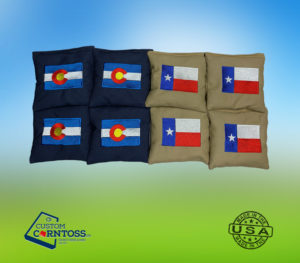 According to the American Cornhole Association (ACA), the abiding authority on all things cornhole, cornhole bags must be a minimum of 6″ x 6″, although some bags can be as big as 8″ x 8″. Whichever dimensions you choose, you should be sure that your cornhole bags are square.
According to the American Cornhole Association (ACA), the abiding authority on all things cornhole, cornhole bags must be a minimum of 6″ x 6″, although some bags can be as big as 8″ x 8″. Whichever dimensions you choose, you should be sure that your cornhole bags are square.
The dimensions you choose depend entirely on personal preferences. Smaller bags are easier for smaller hands to manage, which is useful to keep in mind if cornhole is one of your family bonding activities.
Whether you opt for 6″ x 6″ or 8″ x 8″ or somewhere in between, remember that your bags should be roughly the same weight. Official cornhole bags are supposed to be between 14 and 16 ounces.
ACA also specifies that the bags must be stitched together with a 1/4″ double-stitched seam.
Material
Now that you know how big are cornhole bags, consider another important element of the bags: the material.
The bags themselves should be made of duck cloth, which is a durable, thick fabric that can resist a lot of wear and tear. It also slides well on properly glossed cornhole boards.
Duck cloth feels like canvas and comes in a variety of colors, which is important because each team needs different colored bags to make keeping score easier. If you need a refresher on how to keep score, we have another post to help you out.
The cornhole bag filling gives the bag its weight. Some players prefer to use bags with the traditional corn filling while others opt for plastic pellets.
With different sizes, materials, and colors to choose from, cornhole is a highly customizable game!
Where To Get Bags
It is possible to make your own cornhole bags, but unless you have a sewing machine and time to hunt down the supplies, it is much easier to buy a pre-made set. Cornhole bags are not expensive and they can last for years with minimal maintenance.
Simple bags are a pretty safe bet, but you always have the option to personalize a set with custom embroidery, logos, glow-in-the-dark, and other features.
While it might be cheaper, easier and quicker to just pick up a set while out at a big box store, you get far more bang for your buck by ordering from a cornhole specialist (like Custom Conrtoss!). Big box sores don’t specialize in cornhole, so the products they sell aren’t necessarily official.
For example, looking at the product offerings at two of the nation’s most popular big box stores, the cornhole bag options were very sad! One set was only 4″ x 4″. Another wasn’t even square, measuring 7.5″ x 6.5″. Nether brand was made of the recommended duck cloth; one was cotton, the other polyester. Duck cloth is far more durable in the outdoors and provides a better game play experience.
Now that you know how big are cornhole bags supposed to be, it’s time to play. Swing by our online store, grab a set of cornhole bags, and go have some fun!
- Published in Information
How to Apply Cornhole Decals
Decals are a quick and easy alternative to painting cornhole boards. However, if you have never applied decals before, this task can seem daunting. But don’t fret: we’ll show you how to apply cornhole decals perfectly each and every time.
Choose a Method: Wet or Dry
There are two general methods for applying cornhole decals: wet or dry. The method you choose will depend on the type of decal you wish to apply and your experience with decal application.
Wet and dry applications are very similar except wet application uses a bit of water in the process, as the name implies. Remember that decals should only be applied to clean surfaces for best results.
Method One: Wet Application
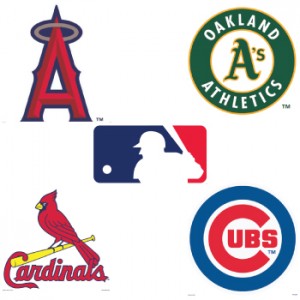 Generally speaking, wet application is better for first-timers because it is more forgiving, allowing you to slide the decal around a bit before making the final placement. Here’s how to apply cornhole decals with the wet method:
Generally speaking, wet application is better for first-timers because it is more forgiving, allowing you to slide the decal around a bit before making the final placement. Here’s how to apply cornhole decals with the wet method:
- Decals should only be applied to clean surfaces. Wipe down your boards to remove any debris.
- Before applying your decal, be sure to measure and re-measure its placement. Marking your board lightly with a wax or graphite pencil can help you keep the decal on target when you begin the application process.
- Once you are comfortable with your decal’s placement and have marked guidelines on your board, lightly mist the board with a solution of one drop of dish soap per 12 ounces of water.
- Peel off the backing tape of your decal and mist the back of the decal too.
- Place the decal on your board according to the guidelines you made, starting from one edge and slowly laying down the rest of the decal. You should be able to slide the decal slightly if you miss your marks.
- Use a credit card or squeegee to smooth out the surface of the decal. This will help you massage out those pesky air bubbles that are a seemingly unavoidable part of decal application.
Method Two: Dry Application
The dry application process is a little less forgiving than the wet application process because once the decal touches your board it is pretty much stuck. For dry application, your board and decal need to be clean and dry. To apply decals with the dry method:
- Measure and re-measure your decal’s placement. Wax or graphite pencils are great for making light marks to serve as guidelines for your decal’s placement.
- Once you are satisfied with your decal’s placement, tape one edge of the decal, preferably a straight edge, to the board while the decal’s backing sheet is still in place. This tape will serve as a hinge to help keep your decal aligned during application. Painter’s tape works best for this because it harms neither your board nor your decal.
- Flip the decal over so that the backing sheet is facing up.
- Begin to remove the backing sheet, starting at the hinge and peeling off about an inch of the backing sheet.
- Place the now-exposed part of your decal on the board, starting at the hinge and within the guidelines you made in step one.
- Continue to peel off the backing tape, inch by inch. Take your time with this step to ensure that you are staying within your guidelines. Use a credit card or squeegee to smooth out the decal as you go.
Air Bubble Removal
Whichever method you choose, chances are you will have to deal with air bubbles in your decal design. This is an almost unavoidable part of the application process. Thankfully, these bubbles are removable. Here are some tips to help with bursting those pesky bubbles:
- Use gentle strokes with a credit card or squeegee to ensure that your decal goes on as smoothly as possible the first time.
- Starting from the center of the decal, use your credit card or squeegee to push out bubbles once the decal is already applied.
- For bubbles that just won’t go away, you can use a small pin to poke a hole in the bubble. The hole only needs to be large enough for air to escape, and once the bubble is deflated the hole will not be visible. Once you create a hole, you can push air out of the bubble starting from the farthest edge of the bubble and working your way toward the hole.
- Smaller bubbles tend to deflate on their own over time. Allow your boards to sit for a day after you apply cornhole decals. This will allow smaller bubbles to disappear on their own.
Protecting Your Decal
Once you have removed the air bubbles, allow your cornhole board decal to dry for a day (especially if you use the wet method). If you are in a hurry, you can use a hairdryer on low heat to help the decal set more quickly.
Once your decal is dry, you’ll want to apply a polyurethane clear coat to protect your decal from wear-and-tear. We have an all-inclusive blog post on the topic of caring for cornhole boards. You’ll want to check that out before applying the poly.
Cornhole board designs vary greatly, and decals are a great way to customize your set. From sporting teams to college cornhole boards, decals allow you to show your allegiance when playing your favorite game. We have a great selection of cornhole decals; be sure to check them out.
Shop Our Cornhole Decals
- Published in Information
Caring for Cornhole Boards: Applying Poly and Clear Coat
Most cornhole competitors view their boards as a work of art. A lot of thought, effort, time, and money goes into the cornhole board designs. That’s why caring for cornhole boards is so important.
It doesn’t matter if you’re buying a custom set from a professional craftsman, painting cornhole boards on your own, or hoping to apply cornhole decals to an unfinished set, caring for cornhole boards is paramount.
An easy and important way to protect your cornhole boards before you even start playing is to seal them with a clear coat of polyurethane.
Selecting a Clear Coat
Clear coat does exactly what the name states: creates a clear cover that protects whatever design is underneath. Polyurethane, commonly referred to as just poly, is the clear coat of choice when caring for cornhole boards and the best coating for cornhole boards.
Aficionados differ in opinion about the best clear coat to use, but most common brands all function the same. Check at your local home goods store; the sales staff might be able to direct you to their favorite brand of poly.
Whichever brand you choose, be sure the poly is water-based. Water-based poly tends to yellow less over time. Yellowing or cloudiness that occurs immediately upon application tends to disappear once the poly has set.
Also, most cornhole board designers prefer semi-gloss poly because regular gloss poly can be extremely shiny and too slick for cornhole bags to stay on the board during game play.
Steps for Applying Clear Coat
Once you have selected your clear coat, it is time to begin preparing for the actual application process. Follow these steps to get the best clear coat possible:
- Make sure your work space is as clean and dust-free as possible. Floating hair, lint, and dust particles that settle on your board during the clear coat application process will be permanently sealed in your board.
- Lay down a tarp to protect whatever surface you are working on. Garages, spare bedrooms, or a traffic-free corner of a living room can make good work spaces.
- Make sure your cornhole boards are clean and free of particles and debris before applying your first coat of poly.
- Follow the directions on your can of poly. Poly is not paint, so do NOT shake the can as this will result in lots of little bubbles.
- Use a foam brush to apply every coat of poly. Never use a roller to apply poly as rollers also create lots of little bubbles. If your foam brush is too wide to fit in the can, feel free to cut it down to size so that you do not need to transfer the poly to another container.
- Getting a clear, even coat takes time, so DO NOT RUSH the process. Most people do five to ten coats of poly, and it is best to wait a few hours between applications.
- To help your coats dry faster and keep ventilation circulating, you can use an oscillating fan set on low speed. However, it is best to wait for 20 minutes after the coat has been applied before turning the fan on as the air movement on wet poly can create bubbles.
- To protect your foam brush, you can wrap it in aluminum foil and place it in an air-tight container. This will allow you to reuse the same brush for each coat of poly.
- After you have applied all but the last coat, it is a good idea to gently sand the surface of your boards. Gentle is a key word here. Use a fine sand paper (320 grit or higher) to smooth the surface of your boards. Try to avoid sanding over any decals.
- Clean your board of dust after sanding and apply the final coat of poly. Allow to dry for 72 hours before playing your first round of cornhole. If your gloss feels somewhat sticky to the touch even after it has dried for this time, a dusting of cornstarch will take the stickiness away.
- Don’t forget to apply poly to the sides and legs of your board. Many people do fewer layers, only two or three coats, in these areas.
Remember: do not rush! Have patience when applying your poly clear coat. Going too fast can create bubbles, cloudiness, and cracked under-layers. Take your time and your smooth, glossy boards will be worth it!
Caring for cornhole boards after customization is the best way to protect your investment for years of cornhole enjoyment. Talk to us about how to maintain your game equipment after purchasing some of our custom cornhole boards. Custom Corntoss wants to ensure our high-quality craftsmanship lasts as long as your cornhole obsession!
- Published in Information
In Need of Family Bonding Time? Try Cornhole!
Getting your kids, especially those teens, interested in family activities is sometimes challenging. However, it’s possible cornhole might be the answer to all your family bonding dilemmas!
What’s the Draw?
It’s pretty obvious why people play cornhole at tailgating parties. It even makes sense to hold a charity cornhole tournament. But why should the family play?
It’s fun.


It provides frustration-free education.
Cornhole requires concentration and good aim in order to get the cornhole bag on the board. It requires even more skill to get the bag through the hole in the board. However, the skill level isn’t so intense that younger members of the family are excluded. Tossing is a simple motion that is perfected with practice while playing cornhole.
In addition to being a simple family activity, cornhole can also serve as an opportunity for the whole family to develop basic athletic skills. Playing cornhole regularly will help develop skills like hand-eye coordination and aim. A friendly round of the game also teaches the virtues of teamwork and healthy competition.
It’s low maintenance.
Have you ever set out to engage in some family bonding, only to lose everyone’s interest before the main event even begins? It is so challenging to keep everyone’s attention while getting the fun set up. Fortunately, cornhole is low maintenance.
The game equipment takes up very little space. The boards and bags will fit easily into any closet or garage. To play, all you need to do is plop the boards on the grass and pass out the bags.
It sends everyone outside.
Perhaps the biggest bonus is the fact that cornhole will get the whole family outside. This means no sitting on the couch, no TV, and no mindless texting or Facebooking. While cornhole is not the most rigorous sport on the market, it is a great way to get everyone in the fresh air and exercising. From your youngest family member to your oldest, cornhole is suitable for any age.
Where Can We Play?
Don’t have a backyard? No problem! Cornhole can be played just about anywhere. Set up a game on the sidewalk or parking lot. You can even plan indoor games.
Don’t forget to take your boards with you on any family outing. Whether you are having a picnic in the park, a trip to the beach, or you are tailgating at your favorite sporting event, the game can be adapted to virtually any setting.
Don’t forget, family bonding can include other people too. Use your cornhole boards to get to know your neighbors and make new friends. A little friendly competition and the convivial atmosphere that surrounds cornhole is a surefire way to break the ice with those neighbors you have been meaning to go over and meet. And if your neighborhood is hosting a block party or cookout, you already know that you can bring cornhole to contribute!
What About The Price?
Cornhole is an affordable investment that can be used by the whole family, young or old. Once you buy or make two boards and eight bags, you are set to play cornhole for many years to come. Few games offer such benefit with so little investment.
Complete cornhole sets come in a variety of customizable options. Check out the boards and bags we have available in our online store.
With all of the positive aspects of this simple, affordable game, it’s plain to see why cornhole has become an enduring favorite. The game’s combination of simplicity, addictiveness and affordability make it an obvious choice for family bonding. Cornhole would be a fantastic addition to any family’s home.
- Published in Information
Cornhole: How to Keep Score
One of the best things about the ever-popular game of cornhole is that the equipment, game play, and cornhole scoring system are all simple. In this post we’ll give you a full run-down on how to play cornhole and how to keep score like a pro! For more information on how to play checkout our complete guide to cornhole which includes a section on cornhole rules.
Cornhole Set-Up: The Basics
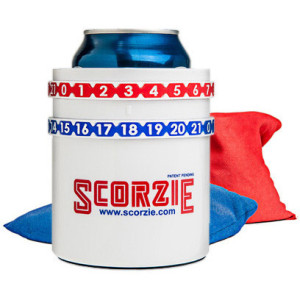

Both teams get four bags that are different colors or distinguishable in some other way. The goal of the game is to be the first team to score 21 or more points. How points are scored is discussed in the next section.
Earning Cornhole Points
Players toss one bag a time, alternating with their opponent until both teams have thrown all of their bags. Cornhole points are given as follows:
- Throw a cornhole (bag goes in the hole): 3 points
- Throw a bag in-the-count (bag lands on any portion of the board): 1 point
- Throw a bag out-of-the-count (bag lands anywhere else): 0 points
It is important to note that bags knocked in the hole during game play will count as a cornhole. Bags that land on the board but are knocked off will be a bag out-of-the-count and not score any corn hole points. These are important factors to consider when devising your cornhole tossing techniques.
Cancellation Scoring
Points are tallied at the end of each inning using cancellation scoring, meaning that points scored by both teams will cancel each other out.
For example, if Team A scores 5 points in the inning and Team B only scores 2 points, then the total points for that inning will be 3 points for Team A and none for Team B. Because Team A won the inning, Team A will be the first to toss in the next inning.
A game cannot end mid-inning. All players must have a chance to toss their bags before the final score is tallied.
Other Options for Scoring
How to keep score while playing cornhole is pretty simple, though some players choose to mix up the rules a bit with these different approaches to scoring. The following rules are optional if you want to make the game run longer or shorter, depending on the rule.
- Skunks: There are two ways to calculate a skunk game. Players can call a skunk when the score is 13-0 at the end of any inning. Or, a skunk could happen if one team scores 7 points in an inning and the other team does not score any points. If the game is a skunk, then the team with the most points wins.
- Play to 21 Exactly: The official rules state that a team must earn 21 points or more to win the game. However, some players choose to play an alternate version where the team must get exactly 21 points. If a team scores over 21 points, then that team reverts back at 13 points. Both teams continue play until one team has exactly 21 points at the end of an inning.
- Win by 2 or More Points: Some cornhole enthusiasts choose to play with the rule that the winning team must win by 2 or more points.
- Tie Breaker: If both teams are tied at 21 points at the end of an inning, play continues until one team has a higher score at the end of an inning.
Foul Play
Cornhole is pretty simple, but there are quite a few ways that a foul can be called. Possible causes for a foul include:
- Overstepping the foul line: Boards are set 27 feet apart and the front edge of the board is the boundary line for adult play. Stepping beyond the front of your board is grounds for a foul.
- Bag hits the ground: Bags that hit the ground and bounce onto the board are considered a foul and should be removed from the board so that they do not impede game play for the rest of the inning. Players may not re-toss foul bags.
- Foul bags disrupting other bags: If a foul bag (i.e. one that bounces onto the board) either knocks another bag off the board or into the hole, then the foul bag must be removed and the original bag must be returned to its scoring position.
- 20-second limit: Cornhole bags must be tossed within 20 seconds from the start of the inning or from the previous player’s toss. Player who fail to deliver within the 20 second time limit will receive a foul.
- Bag pitched by another player or from a different pitcher’s box: The rules of cornhole state that cornhole bags must be pitched by the same player from the same pitcher’s box from the start of each inning. Players may swap out between innings, but whoever starts an inning must finish it or else a foul will be called.
- Bag removal from cornhole court: Any player who removes bags from the court prior to the end of an inning will have all of their bags declared foul from that inning.
- Dropped bags: Cornhole bags dropped by a player prior to pitching are not considered a foul and may be retrieved and pitched with no penalty.
Scoring Terminology
Now that you know all about how to keep score like a pro, here are some essential terms to make you sound like a pro too!
- Corn On The Cob: When a player puts every bag on the board
- Cornhole, Holer, Corn in the Hole: A bag that ends up in the hole
- Dos Cornholes: Throwing two bags in the hole
- Get that corn outta my face!: A term used whenever you successfully counteract your opponent’s attempt to score. For example, when you put a bag in the hole immediately after your opponent does or when you successfully knock your opponent’s bag off the board
- Holy Moly Triple Cornholy: Throwing 3 bags in the hole
- Nothin’ But Corn: When a bag is tossed right through the hole without touching the board
- The Great Cornholio: A person that throws 4 bags in the hole. All present are required to bow down in reverence to this cornholer
- Woody, Boarder: A bag that ends up on the board.
Tool that Make Scoring Easier
If you are hosting a cornhole tournament, you’ll probably need an official way to track the score. Even unofficial cornhole events can benefit from a little scoring assistance, especially if adult beverages are involved!
There are plenty of options to choose from. Custom Corntoss has a score tower, score strips to attach to the cornhole boards and score koozies (you can find all these scoring tools with the other accessories in our shop). Other cornhole fanatics use scoring apps.
Do you have any other ideas for how to keep score or other cornhole terms that you use with your friends? Share with us in the comments below!
- Published in Information

